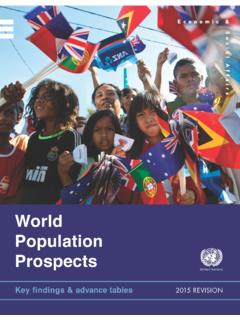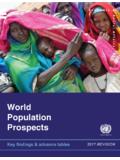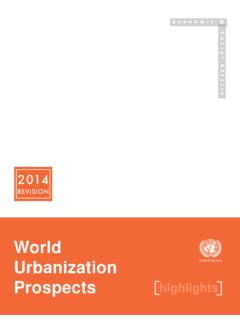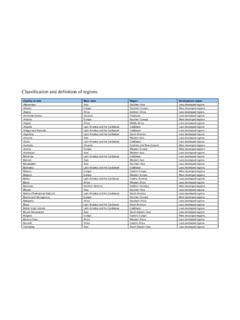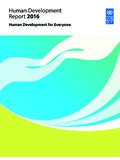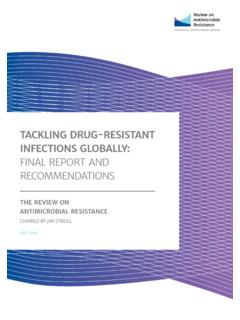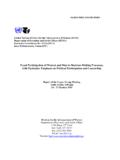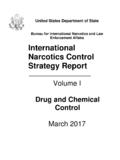Transcription of Key Findings WPP 2015 Final - UN DESA | United …
1 ESA/ Department of Economic and Social Affairs population Division world population prospects The 2015 Revision Key Findings and Advance Tables United nations New York, 2015 DESA The Department of Economic and Social Affairs of the United nations Secretariat is a vital interface between global policies in the economic, social and environmental spheres and national action. The Department works in three main interlinked areas: (i) it compiles, generates and analyses a wide range of economic, social and environmental data and information on which States Members of the United nations draw to review common problems and take stock of policy options; (ii) it facilitates the negotiations of Member States in many intergovernmental bodies on joint courses of action to address ongoing or emerging global challenges.
2 And (iii) it advises interested Governments on the ways and means of translating policy frameworks developed in United nations conferences and summits into programmes at the country level and, through technical assistance, helps build national capacities. Note The designations employed in this report and the material presented in it do not imply the expression of any opinion whatsoever on the part of the Secretariat of the United nations concerning the legal status of any country, territory, city or area or of its authorities, or concerning the delimitation of its frontiers or boundaries.
3 Symbols of United nations documents are composed of capital letters combined with figures. This publication has been issued without formal editing. Suggested citation: United nations , Department of Economic and Social Affairs, population Division (2015). world population prospects : The 2015 Revision, Key Findings and Advance Tables. Working Paper No. ESA/ Cover photo credit: UN Photo/Martine Perret. ERRATUM: Values in the advance tables have been updated for Cabo Verde, Cambodia, Cameroon and Canada. United nations Department of Economic and Social Affairs/ population Division 1 world population prospects : The 2015 Revision, Key Findings and Advance Tables world population prospects : THE 2015 REVISION SUMMARY AND KEY Findings Understanding the demographic changes that are likely to unfold over the coming years, as well as the challenges and opportunities that they present for achieving sustainable development, is important for designing and implementing the post-2015 development agenda.
4 The 2015 Revision of world population prospects is the twenty-fourth round of official United nations population estimates and projections that have been prepared by the population Division of the Department of Economic and Social Affairs of the United nations Secretariat. The 2015 Revision builds on the previous revision by incorporating additional results from the 2010 round of national population censuses as well as Findings from recent specialized demographic and health surveys that have been carried out around the world . The 2015 Revision provides the demographic data and indicators to assess population trends at the global, regional and national levels and to calculate many other key indicators commonly used by the United nations system.
5 Snapshot of global population in 2015 According to the results of the 2015 Revision, the world population reached billion as of mid-2015 (table 1), implying that the world has added approximately one billion people in the span of the last twelve years. Sixty per cent of the global population lives in Asia ( billion), 16 per cent in Africa ( billion), 10 per cent in Europe (738 million), 9 per cent in Latin America and the Caribbean (634 million), and the remaining 5 per cent in Northern America (358 million) and Oceania (39 million).
6 China ( billion) and India ( billion) remain the two largest countries of the world , both with more than 1 billion people, representing 19 and 18 per cent of the world s population , respectively. TABLE 1. population OF THE world AND MAJOR AREAS, 2015, 2030, 2050 AND 2100, ACCORDING TO THE MEDIUM-VARIANT PROJECTION Major area population (millions) 2015 2030 2050 2100 world .. 7 349 8 501 9 725 11 213 Africa .. 1 186 1 679 2 478 4 387 Asia .. 4 393 4 923 5 267 4 889 Europe .. 738 734 707 646 Latin America and the Caribbean.
7 634 721 784 721 Northern America .. 358 396 433 500 Oceania .. 39 47 57 71 Source: United nations , Department of Economic and Social Affairs, population Division (2015). world population prospects : The 2015 Revision. New York: United nations . In 2015, per cent of the world s population is male and per cent is female (figure 1). The median age of the global population , that is, the age at which half the population is older and half is younger, is years. About one-quarter (26 per cent) of the world s people are under 15 years of age, 62 per cent are aged 15-59 years, and 12 per cent are 60 or over.
8 2 United nations Department of Economic and Social Affairs/ population Division world population prospects : The 2015 Revision, Key Findings and Advance Tables Figure 1. Distribution of the world s population by age and sex, 2015 Source: United nations , Department of Economic and Social Affairs, population Division (2015).
9 world population prospects : The 2015 Revision. New York: United nations . Projected growth in the world population Currently, the world population continues to grow though more slowly than in the recent past. Ten years ago, world population was growing by per cent per year. Today, it is growing by per cent per year, or approximately an additional 83 million people annually. The world population is projected to increase by more than one billion people within the next 15 years, reaching billion in 2030, and to increase further to billion in 2050 and billion by 2100 (figure 2).
10 Figure 2. population of the world : estimates, 1950-2015, medium-variant projection and 80 and 95 per cent confidence intervals, 2015-2100 Source: United nations , Department of Economic and Social Affairs, population Division (2015). world population prospects : The 2015 Revision. New York: United nations .. United nations Department of Economic and Social Affairs/ population Division 3 world population prospects : The 2015 Revision, Key Findings and Advance Tables As with any type of projection, there is a degree of uncertainty surrounding these latest population projections.
